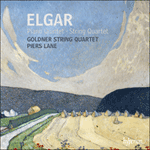
Welcome to Hyperion Records, a British classical label devoted to presenting high-quality recordings of music of all styles and from all periods from the twelfth century to the twenty-first.
Hyperion offers both CDs, and downloads in a number of formats. The site is also available in several languages.
Please use the dropdown buttons to set your preferred options, or use the checkbox to accept the defaults.

| Goldner String Quartet» More |
The second movement sounds artless. Piacevole, Elgar directed it—‘agreeable, pleasant’. Elgar’s wife likened it to ‘captured sunshine’: perhaps the long spells of drowsy repetitions against pedal points made her think of the ‘sound of bees and insects on a hot summer’s afternoon’. But there are also stabs of pain, and the sound, though sweet, is thin, often in only three parts, sprinkled with harmonics and finally muted. This sunshine is fitful and autumnal.
Lady Elgar wrote that the finale is ‘most fiery & sweeps along like Galloping of Squadrons’. The thrust and resolution of the opening justify that description, as does the breadth of the ending. The second subject allows some relaxation, but a phrase from it is then vigorously propelled, so bringing together the motoric power of the first subject and the lyricism of the second.
from notes by Diana McVeagh © 2011
Le second mouvement semble naturel. Piacevole, intime Elgar—«agréable, plaisant». Sa femme apparentait ce passage à «l’éclat du soleil capturé»: peut-être les longs moments de répétitions engourdies, contre des pédales, lui rappelaient-ils «le bruit des abeilles et des insectes par une chaude après-midi d’été». Mais il y a aussi des élancements de douleur et le son, quoique doux, est fluet, souvent à trois parties seulement, saupoudré d’harmoniques et, pour finir, avec sourdine. Il s’agit là d’un soleil intermittent, automnal.
Le finale, écrivit Lady Elgar, est «des plus fougueux, et il entraîne tel un galop d’escadron». Le dynamisme et la résolution de l’ouverture justifient une telle description, tout comme l’ampleur de la conclusion. Le second sujet autorise un brin de détente, mais une de ses phrases, vigoureusement propulsée, réunit ensuite la puissance motorique du premier sujet et le lyrisme du second.
extrait des notes rédigées par Diana McVeagh © 2011
Français: Hypérion
Der zweite Satz klingt arglos. Elgar überschrieb ihn mit Piacevole—„angenehm“, „gefällig“. Elgars Frau verglich ihn mit „festgehaltenem Sonnenschein“: vielleicht erinnerten die langen Passagen schläfriger Wiederholungen gegen Orgelpunkte sie an den „Klang von Bienen und Insekten an einem heißen Sommernachmittag“. Doch kommen auch schmerzvolle Stiche, und der Klang ist bei aller Lieblichkeit dünn, oft nur dreistimmig, mit Flageolett-Tönen gesprenkelt und schließlich gedämpft. Dieser Sonnenschein ist unbeständig und herbstlich.
Lady Elgar schrieb über das Finale, dass es „sehr feurig“ sei und „wie Kavallerie-Galopp“ hinwegfege. Die Schubkraft und Entschlossenheit des Beginns rechtfertigen diese Beschreibung, wie auch die Weite des Endes. Das zweite Thema erlaubt eine gewisse Entspannung, doch wird eine Phrase daraus dann derart heftig vorwärtsgetrieben, dass auf diese Weise die motorische Kraft des ersten Themas und das lyrische Element des zweiten miteinander verbunden werden.
aus dem Begleittext von Diana McVeagh © 2011
Deutsch: Viola Scheffel
 Elgar: Piano Quintet & String Quartet Elgar: Piano Quintet & String QuartetBoth Elgar’s String Quartet and the Piano Quintet are works of great depth and elegance. Their conservative style disregards the compositional trends of the time and displays an unabashed late-romanticism. The disc features sumptuous playing from ...» More |

